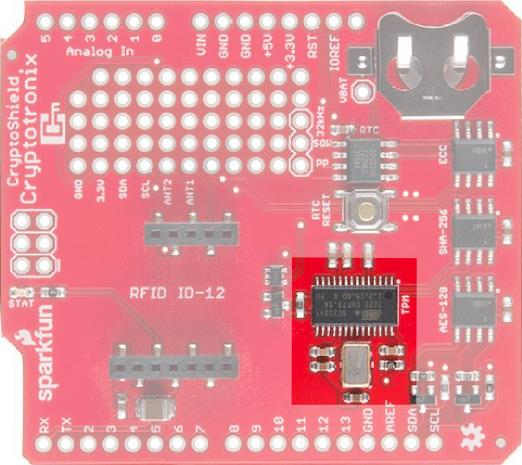Crypto Shield Hookup Guide
This Tutorial is Retired!
This tutorial covers concepts or technologies that are no longer current. It's still here for you to read and enjoy, but may not be as useful as our newest tutorials.
Atmel AT97SC3204T Trusted Platform Module
Overview
The Atmel Trusted Platform Module (TPM) is the AT97SC3204T, and only a summary datasheet is available with an NDA. However, the full datasheet is not required because there is existing software support. The TPM conforms to the Trusted Computer Group (TCG) Software Stack (TSS) Specification version 1.2, which is supported by the TrouSerS Linux software.
A very generic description of the TPM is that it performs RSA encryption, decryption, and signing in the hardware. It can perform much more than that, and there are entire books on how to use the TPM.
NOTE
This chip is one of the more interesting on the Shield, it's also one of the hardest to use. It's easiest to use with a Linux based board but could be used on an AVR. On the AVR, you will have to write a lot of non-trivial software to implement your own driver.
Compliance Vectors
This TPM ships with the compliance vectors loaded. Compliance vectors are well-known keys that are used to test the cryptogrpahic operation of the TPM. You need to clear these vectors and generate your own Endorsement Key. See this blog post for further details.
Using the TPM under Linux
The kernel driver for this TPM did not show up until Kernel version 3.13. Most likely, you will have to reconfigure your kernel to insert this module. This is easier with some board vendors than with others. Configuring your kernel for this module is outside-the-scope of this document.
Once you have the module built and loaded, you can view this page for more instructions on the TPM. Some of the TPM application software in Debian Wheezy is a bit old so you can get a more up-to-date package at debian.cryptotronix.com.
Out of the Arduino shield compatible boards I've tested (this is Josh speaking), none currently have native support for the TPM. I'm trying to work with them to add support. I tested the TPM by fly-wiring the shield to a BeagleBone Black, which does have the kernel driver built in.
Using the TPM with an AVR
Using the TPM with an AVR is even harder than Linux, but it is possible. It's harder because you will have to implement a large number of TPM commands. However, the TPM will respond to commands over I2C just like any other I2C device, so you can write your own code to do this. If you go this route, you will want the review the following resources:
- Trusted Computing Group TPM Specs
- Atmel TPM Kit. This kit is for the AT97SC3205T, but it's mostly backwards compatible. There's code on the dev kit that provides an implementation for a TPM driver using a SAMS4. You might start there to port your driver.
